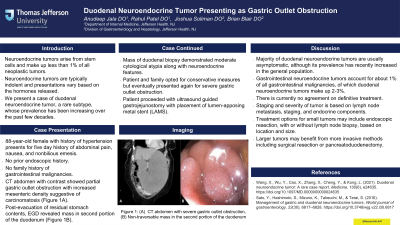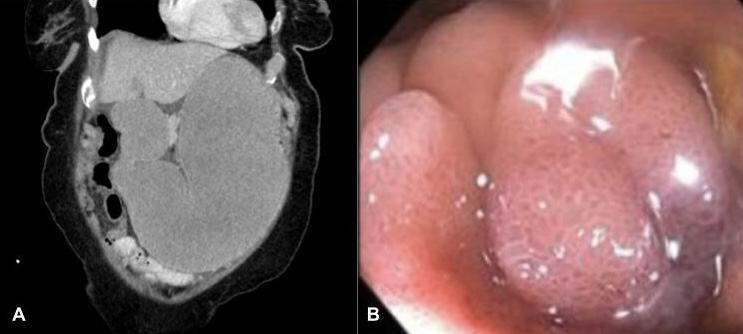Monday Poster Session
Category: Small Intestine
P3311 - Duodenal Neuroendocrine Tumor Presenting as Gastric Outlet Obstruction
Monday, October 28, 2024
10:30 AM - 4:00 PM ET
Location: Exhibit Hall E

Has Audio

Anudeep Jala, DO
Jefferson Health
Washington Township, NJ
Presenting Author(s)
Anudeep Jala, DO1, Rahul Patel, DO1, Joshua Soliman, DO1, Brian Blair, DO2
1Jefferson Health, Washington Township, NJ; 2Jefferson Health, Cherry Hill, NJ
Introduction: Neuroendocrine tumors arise from stem cells and make up less than 1% of all neoplastic tumors. Neuroendocrine tumors are often indolent and have a variety of presentations based on the hormones released, such as facial flushing and diarrhea seen in carcinoid syndrome. Duodenal neuroendocrine tumors are an even rarer subtype of such neuroendocrine tumors. Even with its relative rarity, its presence has been increasing over the past few decades. Our case demonstrates a case of duodenal neuroendocrine cancer presenting with significant gastric outlet obstruction.
Case Description/Methods: An 88-year-old female with a history of hypertension initially presented to the hospital for abdominal pain, nausea, and vomiting for five days. She did not have a prior history of esophagogastroduodenoscopy (EGD) or colonoscopy. Computed tomography (CT) of the abdomen on admission had demonstrated partial gastric outlet obstruction along with increased density in the mesentery suggestive of carcinomatosis. Post evacuation of the residual stomach contents, the patient underwent EGD which had demonstrated a mass in the second portion of the duodenum that was unable to be traversed. Mass of the biopsy was obtained and pathology demonstrated moderate cytologic atypia and neuroendocrine features. Patient denied any further intervention and was discharged from the hospital. Unfortunately, the patient had presented to the hospital again for recurrent gastric outlet obstruction. Given her age, the patient did not want to pursue resection of the mass. She eventually underwent ultrasound guided gastrojejunostomy with placement of lumen-apposing metal stent (LAMS). Given the advanced stage of the cancer, the patient did eventually opt for comfort care measures.
Discussion: The majority of duodenal neuroendocrine tumors are usually asymptomatic. This case demonstrates a rare presentation of a duodenal neuroendocrine tumor presenting with severe gastric outlet obstruction. This type of cancer is very rare but its prevalence has recently increased in the general population. Gastrointestinal neuroendocrine tumors account for about 1% of all gastrointestinal malignancies, of which duodenal neuroendocrine tumors make up only 2 to 3%. Severity of tumor is based on lymph node metastasis, staging, and endocrine components. Although such tumors are slowly growing, early identification is vital for potential therapies including surgery and biologic therapy which is still a field of active research.

Disclosures:
Anudeep Jala, DO1, Rahul Patel, DO1, Joshua Soliman, DO1, Brian Blair, DO2. P3311 - Duodenal Neuroendocrine Tumor Presenting as Gastric Outlet Obstruction, ACG 2024 Annual Scientific Meeting Abstracts. Philadelphia, PA: American College of Gastroenterology.
1Jefferson Health, Washington Township, NJ; 2Jefferson Health, Cherry Hill, NJ
Introduction: Neuroendocrine tumors arise from stem cells and make up less than 1% of all neoplastic tumors. Neuroendocrine tumors are often indolent and have a variety of presentations based on the hormones released, such as facial flushing and diarrhea seen in carcinoid syndrome. Duodenal neuroendocrine tumors are an even rarer subtype of such neuroendocrine tumors. Even with its relative rarity, its presence has been increasing over the past few decades. Our case demonstrates a case of duodenal neuroendocrine cancer presenting with significant gastric outlet obstruction.
Case Description/Methods: An 88-year-old female with a history of hypertension initially presented to the hospital for abdominal pain, nausea, and vomiting for five days. She did not have a prior history of esophagogastroduodenoscopy (EGD) or colonoscopy. Computed tomography (CT) of the abdomen on admission had demonstrated partial gastric outlet obstruction along with increased density in the mesentery suggestive of carcinomatosis. Post evacuation of the residual stomach contents, the patient underwent EGD which had demonstrated a mass in the second portion of the duodenum that was unable to be traversed. Mass of the biopsy was obtained and pathology demonstrated moderate cytologic atypia and neuroendocrine features. Patient denied any further intervention and was discharged from the hospital. Unfortunately, the patient had presented to the hospital again for recurrent gastric outlet obstruction. Given her age, the patient did not want to pursue resection of the mass. She eventually underwent ultrasound guided gastrojejunostomy with placement of lumen-apposing metal stent (LAMS). Given the advanced stage of the cancer, the patient did eventually opt for comfort care measures.
Discussion: The majority of duodenal neuroendocrine tumors are usually asymptomatic. This case demonstrates a rare presentation of a duodenal neuroendocrine tumor presenting with severe gastric outlet obstruction. This type of cancer is very rare but its prevalence has recently increased in the general population. Gastrointestinal neuroendocrine tumors account for about 1% of all gastrointestinal malignancies, of which duodenal neuroendocrine tumors make up only 2 to 3%. Severity of tumor is based on lymph node metastasis, staging, and endocrine components. Although such tumors are slowly growing, early identification is vital for potential therapies including surgery and biologic therapy which is still a field of active research.

Figure: Image 1: (A) CT abdomen with severe gastric outlet obstruction, (B) Non-traversable mass in the second portion of the duodenum
Disclosures:
Anudeep Jala indicated no relevant financial relationships.
Rahul Patel indicated no relevant financial relationships.
Joshua Soliman indicated no relevant financial relationships.
Brian Blair indicated no relevant financial relationships.
Anudeep Jala, DO1, Rahul Patel, DO1, Joshua Soliman, DO1, Brian Blair, DO2. P3311 - Duodenal Neuroendocrine Tumor Presenting as Gastric Outlet Obstruction, ACG 2024 Annual Scientific Meeting Abstracts. Philadelphia, PA: American College of Gastroenterology.
